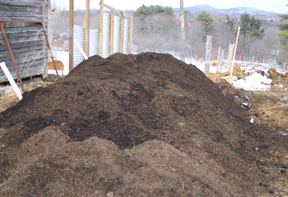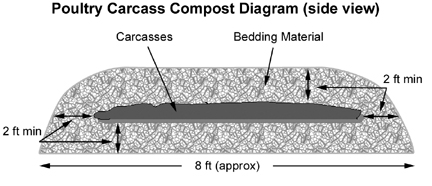Bulletin #12, Safe Disposal of Backyard Poultry Mortalities

Developed by Associate Extension Professor Mark Hutchinson in collaboration with Bill Seekins, Agricultural Management Resource Coordinator for the Maine Department of Agriculture
For information about UMaine Extension programs and resources, visit extension.umaine.edu.
Find more of our publications and books at extension.umaine.edu/publications/.
Many people in Maine keep backyard poultry flocks. If you are among them, you know that even with the best of care, mortalities occasionally occur. Proper disposal of carcasses will minimize risks to you and your family, the remaining flock, and the environment. No mortality should be used for human consumption.
Composting offers a solution
Proper composting is an effective method of carcass disposal. Composting is the natural breakdown of organic material by microbes. A well-constructed compost pile will
- reach temperatures of 130ºF/54ºC to 150ºF/65ºC and maintain these temperatures for at least three consecutive days (check temperatures with compost thermometer);
- inactivate many viruses, including avian influenza (AI) virus (the AI virus becomes inactive within 10 minutes at 140ºF/60ºC, or with 15 to 20 minutes at 133ºF/56ºC); 1
- produce a usable end product.
Steps to successful composting of poultry mortalities
1. Select a suitable site
- Identify an area at least 10 feet by 10 feet with the following characteristics, if possible:
— Away from neighbors’ sight line or screened from view
— Downwind from neighbors
— Near the barn or manure pile
— Gentle slope (ideal is two to four percent)
— Away from drinking water supplies, including domestic wells (preferably at least 100 feet)
— Soil/drainage:
- Medium-textured soils (loamy sand to sandy loam) are best.
- Soils with high seasonal water tables may have to be modified.
- Shallow to bedrock sites need to be modified. Contact one of the resource people from the Maine Compost Team (see “Resources”) if any site modification is needed.
- Consider access to feedstocks (raw material for composting) and nearness to carcasses to be composted.
- Avoid sites where excess water will enter the pile, such as near roof gutters or perimeter drains.
You are unlikely to find a site that meets all of these criteria. Consider all of the factors and decide what location will have the least amount of impact. For additional information on site selection, consult Guidelines for Siting Compost Operations (see “References”).
2. Gather compost material (feedstocks)
- Minimum 5 cubic yards
- Feedstock sources:
— Poultry litter (nitrogen source)
— Wood shavings (carbon source)
— Horse bedding (carbon source)
3. Mix feedstocks in correct ratios
- 1.5 parts sawdust/shavings to 1 part poultry litter, or
- 7 parts horse bedding to 1 part poultry litter
Mix feedstocks in the above ratios before adding mortalities. You will need at least 5 cubic yards of mixed feedstock material to construct a pile large enough to generate and maintain sufficient pile temperatures.
4. Construct pile
 The pile will form a cone shape: pile size should be at least 5 feet high with a base diameter of 8 feet (this size is necessary to create and maintain required heat). A pile this size will hold approximately 200 adult birds.
The pile will form a cone shape: pile size should be at least 5 feet high with a base diameter of 8 feet (this size is necessary to create and maintain required heat). A pile this size will hold approximately 200 adult birds.- Lay 2 feet of mixed material as a base.
- Place a single layer of birds on the base.
- Cover carcasses with an additional 2 feet of mixed material.
- A second layer of birds may be added if necessary. This will increase the height of the pile.
- Cover the second layer with 2 feet of mixed material.
- Make sure all soft tissue is well covered.
5. Monitor and manage pile
- Check pile for activity by scavenging animals or birds.
— Add more carbon cover material, such as wood shavings, dry horse bedding, or mature compost, if there is evidence of animal activity.
- Monitor pile temperature.
— Maintain a temperature of 130ºF/54ºC to 150ºF/65ºC for at least three consecutive days.
— Turn pile with a fork or shovel (or a bucket tractor if available) when temperatures decrease below 100ºF or after approximately three weeks.
— After turning, make sure all soft tissue is covered with absorbent carbon material. This will act as a biofilter.
— After turning, allow the pile to cure for at least three months before applying to soil.
6. Use the finished product
- Apply finished compost at these recommended rates:
— Top-dress lawns with a half-inch layer.
— Amend garden soils with 1 cubic yard per 1,000 square feet.
— Amend crop soils with 25 tons per acre.
1 H. Lu et al. “Survival of Avian Influenza Virus H7N2 in SPF Chickens and Their Environments.” Avian Diseases 47 (2003): 1015-1021.
Resources:
Maine Compost Team
Mark King, Maine Department of Environmental Protection, State House Station #17, Augusta, Maine 04333, 207.287.2430 or Mark.A.King@maine.gov
Mark Hutchinson, University of Maine Cooperative Extension, Knox-Lincoln Counties Office, 377 Manktown Road, Waldoboro, ME 04572, 207.832.0343 or mhutch@maine.edu
References:
- Rocque, David. Guidelines for Siting Compost Operations (Draft). Augusta, ME: Maine Department of Agriculture Food and Rural Resources, 2005.
- Rynk, Robert, ed. On-Farm Composting Handbook. Ithaca, NY: Natural Resource, Agriculture and Engineering Service, 1992. (Available from UMaine Extension.)
- Biosecurity for the Birds, USDA Animal and Plant Health Inspection Service.
- Maine Compost School.
Information in this publication is provided purely for educational purposes. No responsibility is assumed for any problems associated with the use of products or services mentioned. No endorsement of products or companies is intended, nor is criticism of unnamed products or companies implied.
© 2006, updated 2015
Call 800.287.0274 (in Maine), or 207.581.3188, for information on publications and program offerings from University of Maine Cooperative Extension, or visit extension.umaine.edu.
In complying with the letter and spirit of applicable laws and pursuing its own goals of diversity, the University of Maine System does not discriminate on the grounds of race, color, religion, sex, sexual orientation, transgender status, gender, gender identity or expression, ethnicity, national origin, citizenship status, familial status, ancestry, age, disability physical or mental, genetic information, or veterans or military status in employment, education, and all other programs and activities. The University provides reasonable accommodations to qualified individuals with disabilities upon request. The following person has been designated to handle inquiries regarding non-discrimination policies: Director of Institutional Equity and Title IX Services, 5713 Chadbourne Hall, Room 412, University of Maine, Orono, ME 04469-5713, 207.581.1226, TTY 711 (Maine Relay System).

